A Comprehensive Analysis of Unilever's Business Environment
VerifiedAdded on 2023/06/30
|6
|1215
|395
Report
AI Summary
This report provides a detailed analysis of Unilever's external and internal environments, focusing on the strategies and models employed by the company to navigate the market and maintain a competitive edge. The external environment analysis explores factors such as social, technological, political, and economic influences, while the internal environment competence analysis assesses Unilever's strengths using models like McKinsey 7S, VRIOS framework, and Mintzberg 5Ps model. The report highlights Unilever's use of TAM, SAM, and SOM for market size assessment, Life Cycle Assessment (LCA) for environmental performance improvement, and Blue Ocean/Red Ocean strategies for market positioning. It also identifies key competitors like Proctor & Gamble and L’Oreal, emphasizing the need for Unilever to adapt quickly to market changes and continue innovating to sustain its market position. This report provides valuable insights into Unilever's strategic approaches and operational efficiencies.
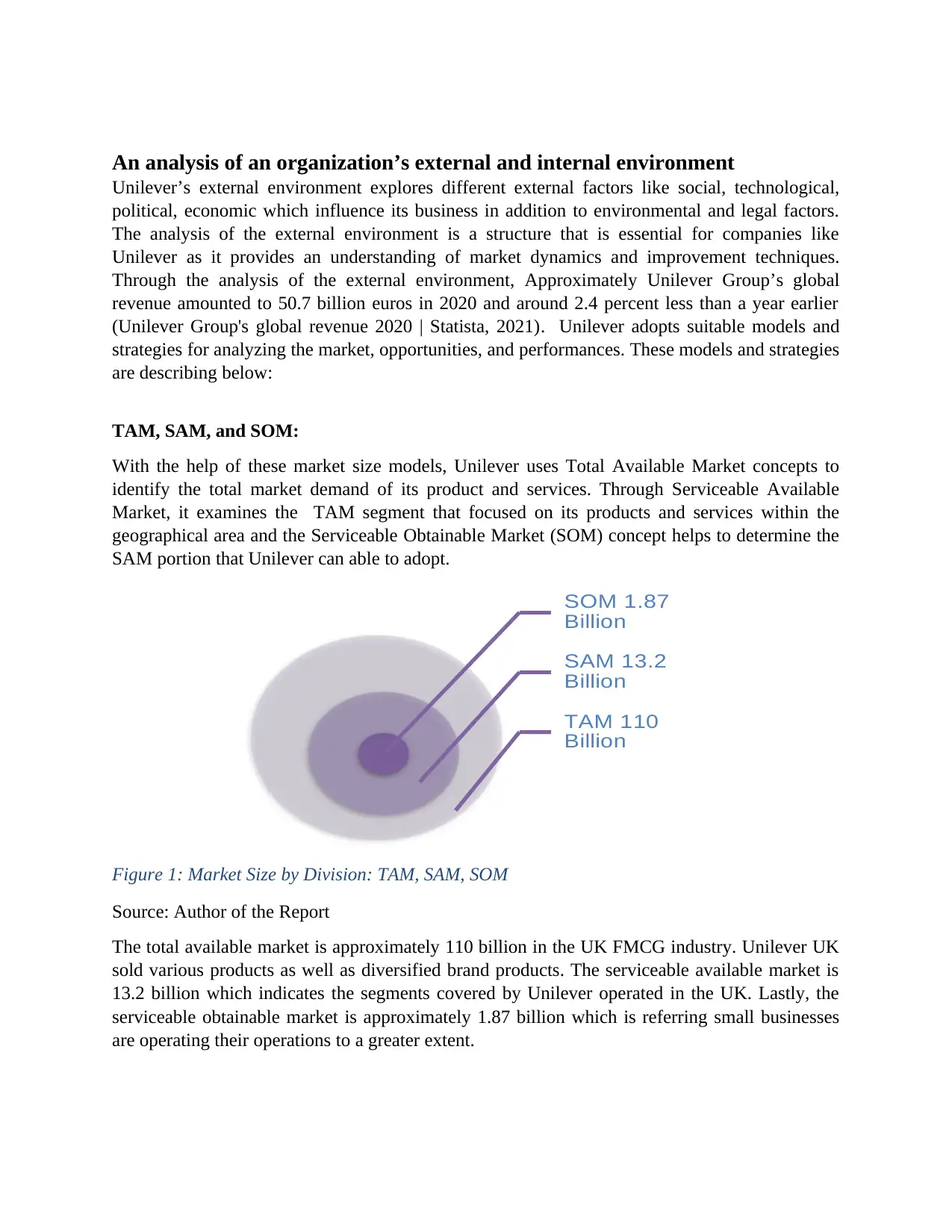
An analysis of an organization’s external and internal environment
Unilever’s external environment explores different external factors like social, technological,
political, economic which influence its business in addition to environmental and legal factors.
The analysis of the external environment is a structure that is essential for companies like
Unilever as it provides an understanding of market dynamics and improvement techniques.
Through the analysis of the external environment, Approximately Unilever Group’s global
revenue amounted to 50.7 billion euros in 2020 and around 2.4 percent less than a year earlier
(Unilever Group's global revenue 2020 | Statista, 2021). Unilever adopts suitable models and
strategies for analyzing the market, opportunities, and performances. These models and strategies
are describing below:
TAM, SAM, and SOM:
With the help of these market size models, Unilever uses Total Available Market concepts to
identify the total market demand of its product and services. Through Serviceable Available
Market, it examines the TAM segment that focused on its products and services within the
geographical area and the Serviceable Obtainable Market (SOM) concept helps to determine the
SAM portion that Unilever can able to adopt.
Figure 1: Market Size by Division: TAM, SAM, SOM
Source: Author of the Report
The total available market is approximately 110 billion in the UK FMCG industry. Unilever UK
sold various products as well as diversified brand products. The serviceable available market is
13.2 billion which indicates the segments covered by Unilever operated in the UK. Lastly, the
serviceable obtainable market is approximately 1.87 billion which is referring small businesses
are operating their operations to a greater extent.
SOM 1.87
Billion
SAM 13.2
Billion
TAM 110
Billion
Unilever’s external environment explores different external factors like social, technological,
political, economic which influence its business in addition to environmental and legal factors.
The analysis of the external environment is a structure that is essential for companies like
Unilever as it provides an understanding of market dynamics and improvement techniques.
Through the analysis of the external environment, Approximately Unilever Group’s global
revenue amounted to 50.7 billion euros in 2020 and around 2.4 percent less than a year earlier
(Unilever Group's global revenue 2020 | Statista, 2021). Unilever adopts suitable models and
strategies for analyzing the market, opportunities, and performances. These models and strategies
are describing below:
TAM, SAM, and SOM:
With the help of these market size models, Unilever uses Total Available Market concepts to
identify the total market demand of its product and services. Through Serviceable Available
Market, it examines the TAM segment that focused on its products and services within the
geographical area and the Serviceable Obtainable Market (SOM) concept helps to determine the
SAM portion that Unilever can able to adopt.
Figure 1: Market Size by Division: TAM, SAM, SOM
Source: Author of the Report
The total available market is approximately 110 billion in the UK FMCG industry. Unilever UK
sold various products as well as diversified brand products. The serviceable available market is
13.2 billion which indicates the segments covered by Unilever operated in the UK. Lastly, the
serviceable obtainable market is approximately 1.87 billion which is referring small businesses
are operating their operations to a greater extent.
SOM 1.87
Billion
SAM 13.2
Billion
TAM 110
Billion
Paraphrase This Document
Need a fresh take? Get an instant paraphrase of this document with our AI Paraphraser
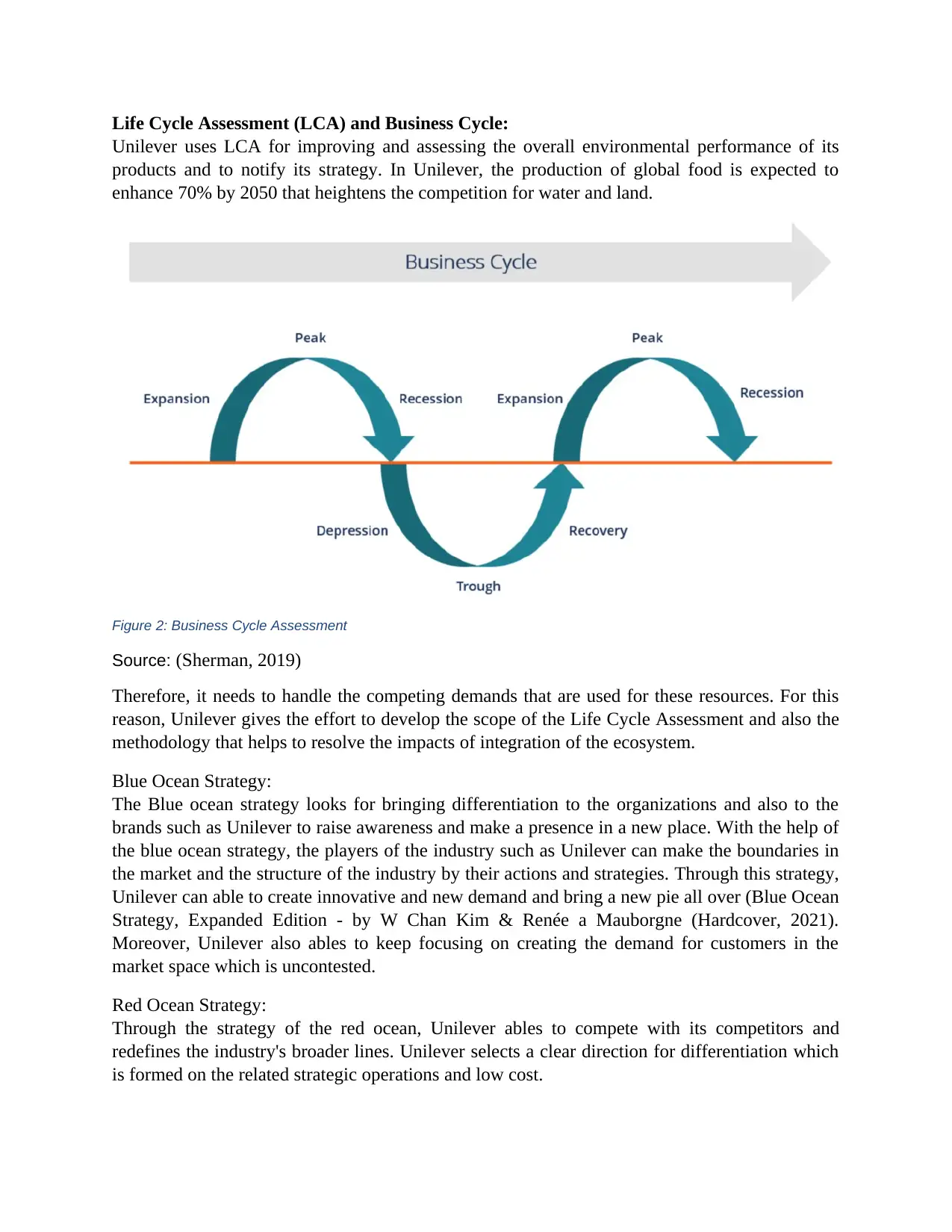
Life Cycle Assessment (LCA) and Business Cycle:
Unilever uses LCA for improving and assessing the overall environmental performance of its
products and to notify its strategy. In Unilever, the production of global food is expected to
enhance 70% by 2050 that heightens the competition for water and land.
Figure 2: Business Cycle Assessment
Source: (Sherman, 2019)
Therefore, it needs to handle the competing demands that are used for these resources. For this
reason, Unilever gives the effort to develop the scope of the Life Cycle Assessment and also the
methodology that helps to resolve the impacts of integration of the ecosystem.
Blue Ocean Strategy:
The Blue ocean strategy looks for bringing differentiation to the organizations and also to the
brands such as Unilever to raise awareness and make a presence in a new place. With the help of
the blue ocean strategy, the players of the industry such as Unilever can make the boundaries in
the market and the structure of the industry by their actions and strategies. Through this strategy,
Unilever can able to create innovative and new demand and bring a new pie all over (Blue Ocean
Strategy, Expanded Edition - by W Chan Kim & Renée a Mauborgne (Hardcover, 2021).
Moreover, Unilever also ables to keep focusing on creating the demand for customers in the
market space which is uncontested.
Red Ocean Strategy:
Through the strategy of the red ocean, Unilever ables to compete with its competitors and
redefines the industry's broader lines. Unilever selects a clear direction for differentiation which
is formed on the related strategic operations and low cost.
Unilever uses LCA for improving and assessing the overall environmental performance of its
products and to notify its strategy. In Unilever, the production of global food is expected to
enhance 70% by 2050 that heightens the competition for water and land.
Figure 2: Business Cycle Assessment
Source: (Sherman, 2019)
Therefore, it needs to handle the competing demands that are used for these resources. For this
reason, Unilever gives the effort to develop the scope of the Life Cycle Assessment and also the
methodology that helps to resolve the impacts of integration of the ecosystem.
Blue Ocean Strategy:
The Blue ocean strategy looks for bringing differentiation to the organizations and also to the
brands such as Unilever to raise awareness and make a presence in a new place. With the help of
the blue ocean strategy, the players of the industry such as Unilever can make the boundaries in
the market and the structure of the industry by their actions and strategies. Through this strategy,
Unilever can able to create innovative and new demand and bring a new pie all over (Blue Ocean
Strategy, Expanded Edition - by W Chan Kim & Renée a Mauborgne (Hardcover, 2021).
Moreover, Unilever also ables to keep focusing on creating the demand for customers in the
market space which is uncontested.
Red Ocean Strategy:
Through the strategy of the red ocean, Unilever ables to compete with its competitors and
redefines the industry's broader lines. Unilever selects a clear direction for differentiation which
is formed on the related strategic operations and low cost.
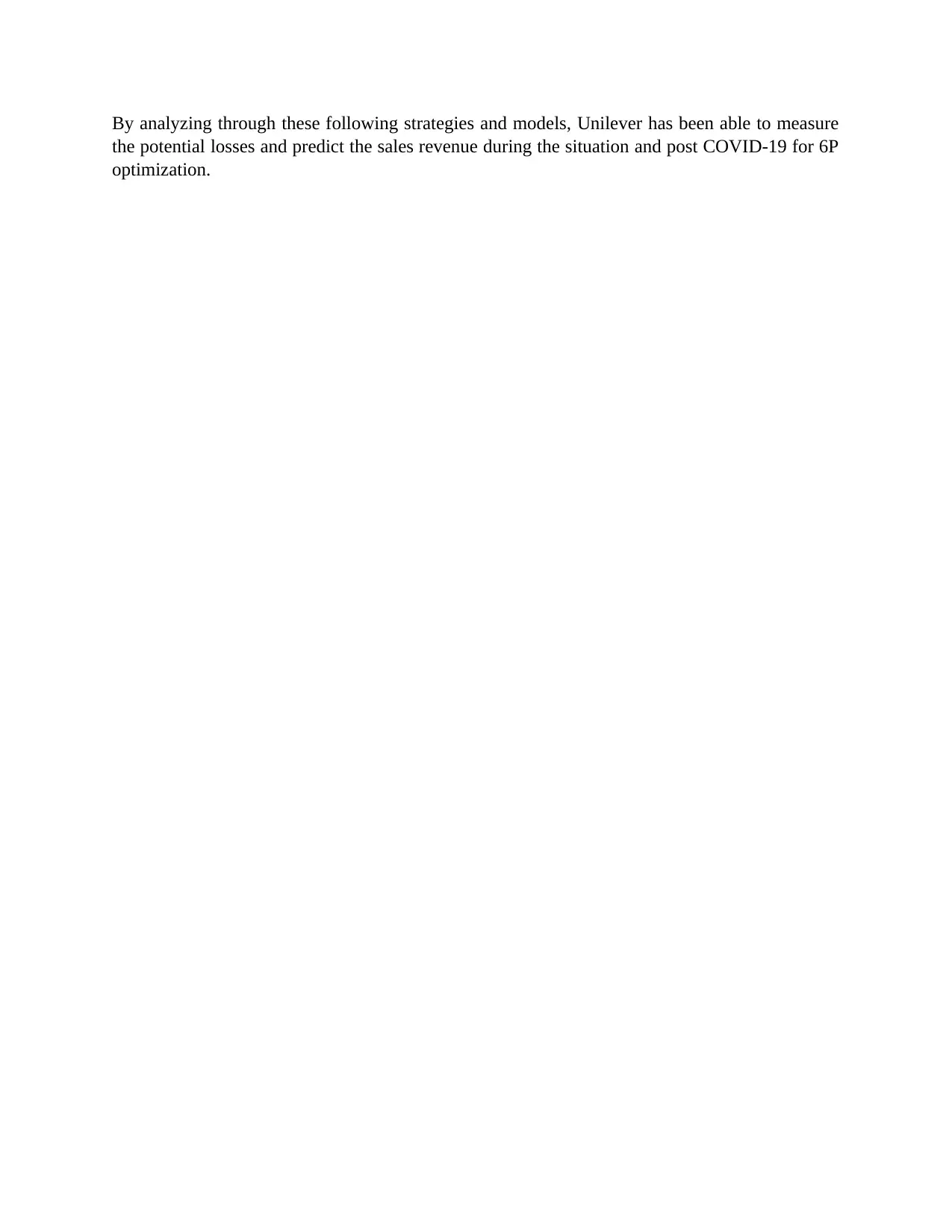
By analyzing through these following strategies and models, Unilever has been able to measure
the potential losses and predict the sales revenue during the situation and post COVID-19 for 6P
optimization.
the potential losses and predict the sales revenue during the situation and post COVID-19 for 6P
optimization.
⊘ This is a preview!⊘
Do you want full access?
Subscribe today to unlock all pages.

Trusted by 1+ million students worldwide
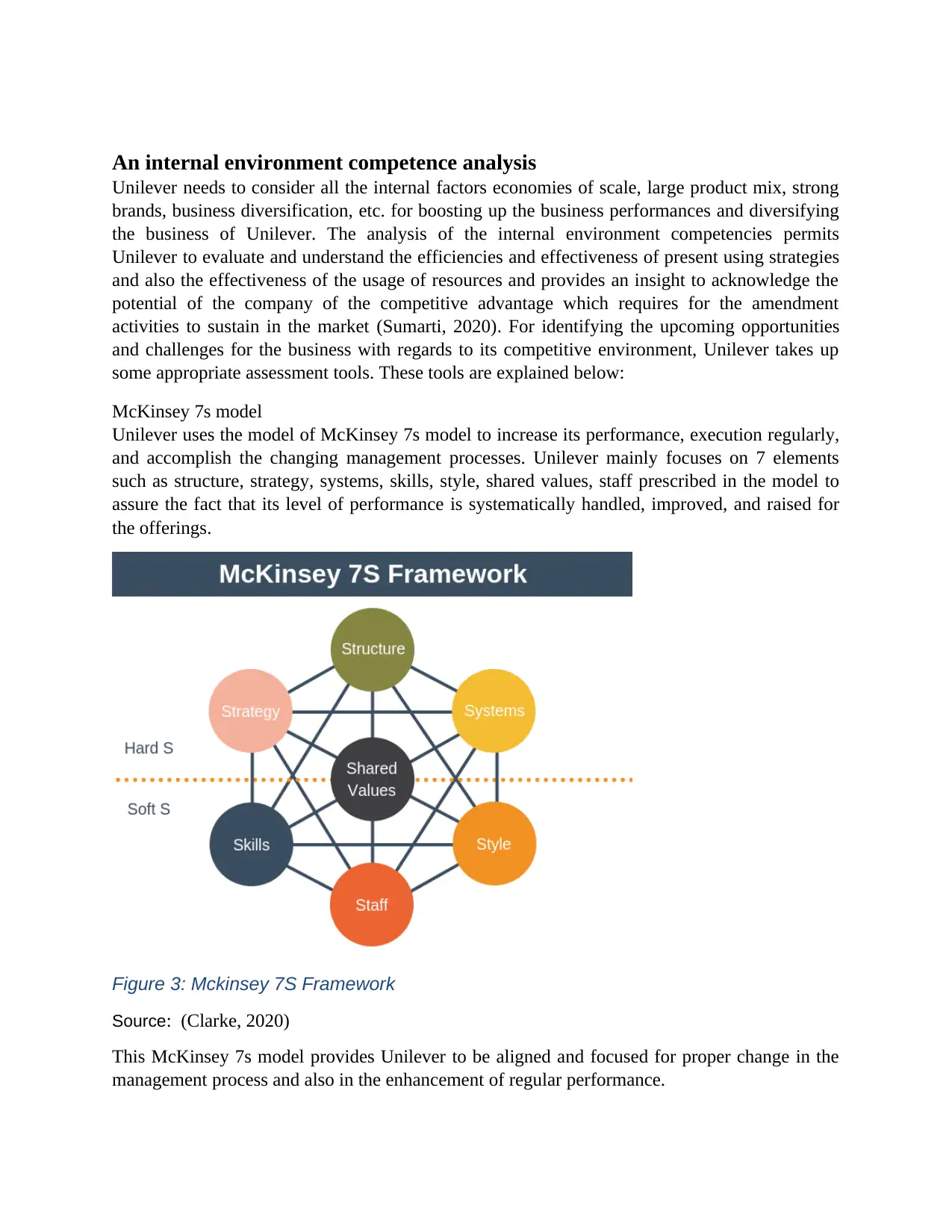
An internal environment competence analysis
Unilever needs to consider all the internal factors economies of scale, large product mix, strong
brands, business diversification, etc. for boosting up the business performances and diversifying
the business of Unilever. The analysis of the internal environment competencies permits
Unilever to evaluate and understand the efficiencies and effectiveness of present using strategies
and also the effectiveness of the usage of resources and provides an insight to acknowledge the
potential of the company of the competitive advantage which requires for the amendment
activities to sustain in the market (Sumarti, 2020). For identifying the upcoming opportunities
and challenges for the business with regards to its competitive environment, Unilever takes up
some appropriate assessment tools. These tools are explained below:
McKinsey 7s model
Unilever uses the model of McKinsey 7s model to increase its performance, execution regularly,
and accomplish the changing management processes. Unilever mainly focuses on 7 elements
such as structure, strategy, systems, skills, style, shared values, staff prescribed in the model to
assure the fact that its level of performance is systematically handled, improved, and raised for
the offerings.
Figure 3: Mckinsey 7S Framework
Source: (Clarke, 2020)
This McKinsey 7s model provides Unilever to be aligned and focused for proper change in the
management process and also in the enhancement of regular performance.
Unilever needs to consider all the internal factors economies of scale, large product mix, strong
brands, business diversification, etc. for boosting up the business performances and diversifying
the business of Unilever. The analysis of the internal environment competencies permits
Unilever to evaluate and understand the efficiencies and effectiveness of present using strategies
and also the effectiveness of the usage of resources and provides an insight to acknowledge the
potential of the company of the competitive advantage which requires for the amendment
activities to sustain in the market (Sumarti, 2020). For identifying the upcoming opportunities
and challenges for the business with regards to its competitive environment, Unilever takes up
some appropriate assessment tools. These tools are explained below:
McKinsey 7s model
Unilever uses the model of McKinsey 7s model to increase its performance, execution regularly,
and accomplish the changing management processes. Unilever mainly focuses on 7 elements
such as structure, strategy, systems, skills, style, shared values, staff prescribed in the model to
assure the fact that its level of performance is systematically handled, improved, and raised for
the offerings.
Figure 3: Mckinsey 7S Framework
Source: (Clarke, 2020)
This McKinsey 7s model provides Unilever to be aligned and focused for proper change in the
management process and also in the enhancement of regular performance.
Paraphrase This Document
Need a fresh take? Get an instant paraphrase of this document with our AI Paraphraser
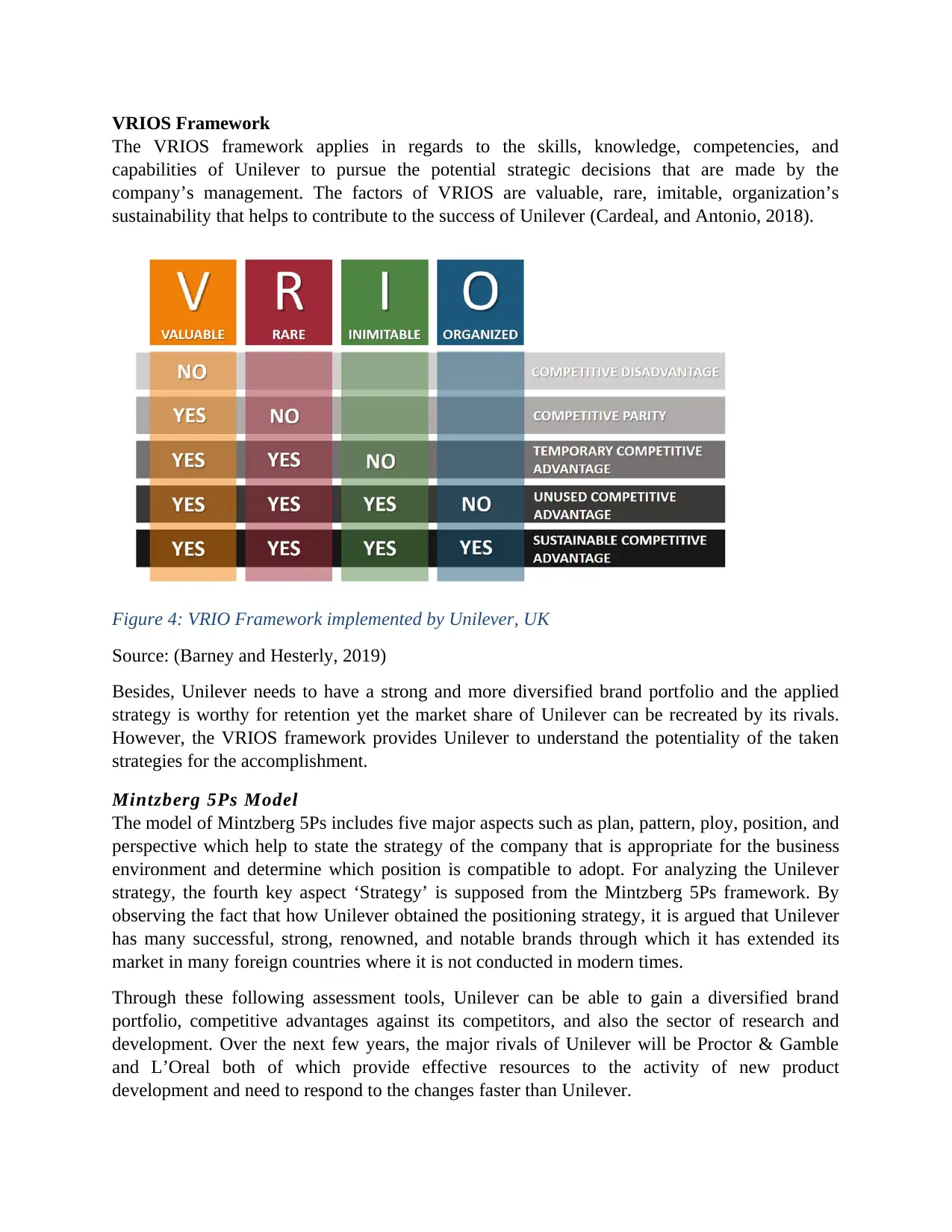
VRIOS Framework
The VRIOS framework applies in regards to the skills, knowledge, competencies, and
capabilities of Unilever to pursue the potential strategic decisions that are made by the
company’s management. The factors of VRIOS are valuable, rare, imitable, organization’s
sustainability that helps to contribute to the success of Unilever (Cardeal, and Antonio, 2018).
Figure 4: VRIO Framework implemented by Unilever, UK
Source: (Barney and Hesterly, 2019)
Besides, Unilever needs to have a strong and more diversified brand portfolio and the applied
strategy is worthy for retention yet the market share of Unilever can be recreated by its rivals.
However, the VRIOS framework provides Unilever to understand the potentiality of the taken
strategies for the accomplishment.
Mintzberg 5Ps Model
The model of Mintzberg 5Ps includes five major aspects such as plan, pattern, ploy, position, and
perspective which help to state the strategy of the company that is appropriate for the business
environment and determine which position is compatible to adopt. For analyzing the Unilever
strategy, the fourth key aspect ‘Strategy’ is supposed from the Mintzberg 5Ps framework. By
observing the fact that how Unilever obtained the positioning strategy, it is argued that Unilever
has many successful, strong, renowned, and notable brands through which it has extended its
market in many foreign countries where it is not conducted in modern times.
Through these following assessment tools, Unilever can be able to gain a diversified brand
portfolio, competitive advantages against its competitors, and also the sector of research and
development. Over the next few years, the major rivals of Unilever will be Proctor & Gamble
and L’Oreal both of which provide effective resources to the activity of new product
development and need to respond to the changes faster than Unilever.
The VRIOS framework applies in regards to the skills, knowledge, competencies, and
capabilities of Unilever to pursue the potential strategic decisions that are made by the
company’s management. The factors of VRIOS are valuable, rare, imitable, organization’s
sustainability that helps to contribute to the success of Unilever (Cardeal, and Antonio, 2018).
Figure 4: VRIO Framework implemented by Unilever, UK
Source: (Barney and Hesterly, 2019)
Besides, Unilever needs to have a strong and more diversified brand portfolio and the applied
strategy is worthy for retention yet the market share of Unilever can be recreated by its rivals.
However, the VRIOS framework provides Unilever to understand the potentiality of the taken
strategies for the accomplishment.
Mintzberg 5Ps Model
The model of Mintzberg 5Ps includes five major aspects such as plan, pattern, ploy, position, and
perspective which help to state the strategy of the company that is appropriate for the business
environment and determine which position is compatible to adopt. For analyzing the Unilever
strategy, the fourth key aspect ‘Strategy’ is supposed from the Mintzberg 5Ps framework. By
observing the fact that how Unilever obtained the positioning strategy, it is argued that Unilever
has many successful, strong, renowned, and notable brands through which it has extended its
market in many foreign countries where it is not conducted in modern times.
Through these following assessment tools, Unilever can be able to gain a diversified brand
portfolio, competitive advantages against its competitors, and also the sector of research and
development. Over the next few years, the major rivals of Unilever will be Proctor & Gamble
and L’Oreal both of which provide effective resources to the activity of new product
development and need to respond to the changes faster than Unilever.
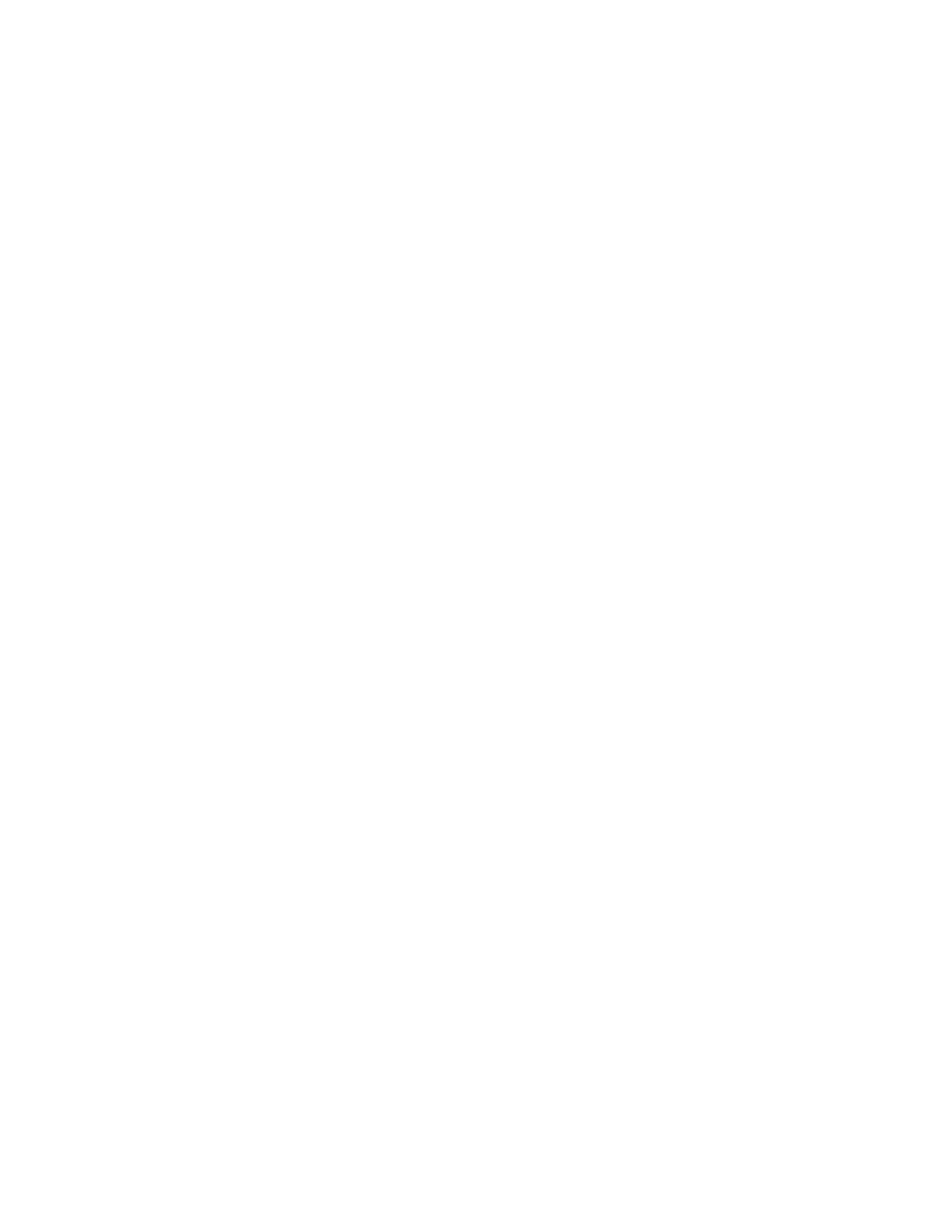
⊘ This is a preview!⊘
Do you want full access?
Subscribe today to unlock all pages.

Trusted by 1+ million students worldwide
1 out of 6
Related Documents
Your All-in-One AI-Powered Toolkit for Academic Success.
+13062052269
info@desklib.com
Available 24*7 on WhatsApp / Email
![[object Object]](/_next/static/media/star-bottom.7253800d.svg)
Unlock your academic potential
Copyright © 2020–2025 A2Z Services. All Rights Reserved. Developed and managed by ZUCOL.





